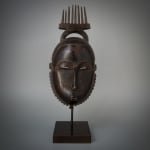Baule Wooden Mask, 19th to early 20th Century CE
Wood
39 x 16 cm
15 3/8 x 6 1/4 in
15 3/8 x 6 1/4 in
ES.6680
Further images
This mask was made by the Baule of the Ivory Coast area and is characterised by heavy eyelids, and a long slim nose which leads to the pouted lips. The...
This mask was made by the Baule of the Ivory Coast area and is characterised by heavy eyelids, and a long slim nose which leads to the pouted lips. The mask is surmounted by an elaborate head-dress with eight spears over a cresscent.
The Baule live across the Ivory Coast area, and have an economy based primarily on sedentary agriculturism. They have thus been able to build up a considerable political and economic stronghold, which has in turn given rise to a strong ritual and artistic heritage. Their own creation story relates to an ancient migration, in which the queen was forced to sacrifice her son in order to ford a mighty river. So upset was she that all she could say was baouli (the child is dead), thus giving rise to the tribe's name.
The fact that many such pieces have a centuries-old patina from handling and libations would seem to suggest that pieces can be inherited, and that the sculptures can either contain more than one spouse, or that s/he can be replaced by the spouse of the new owner. This is particularly the case with valuable or very well-carved pieces. Like most other human societies, the Baule are prey to conspicuous consumption, which is a central key to asserting one's status in the village, and thus one's power and influence. While their carving is among the most refined and restrained in Africa, therefore, artists vie to produce more impressive and beautiful carvings which are often decorated or adorned by their proud owners.
The function of this mask would seem to be diplomatic, probably worn to receive important dignitaries. This is an exceptionally striking example, and a superb addition to any discerning collection.
The Baule live across the Ivory Coast area, and have an economy based primarily on sedentary agriculturism. They have thus been able to build up a considerable political and economic stronghold, which has in turn given rise to a strong ritual and artistic heritage. Their own creation story relates to an ancient migration, in which the queen was forced to sacrifice her son in order to ford a mighty river. So upset was she that all she could say was baouli (the child is dead), thus giving rise to the tribe's name.
The fact that many such pieces have a centuries-old patina from handling and libations would seem to suggest that pieces can be inherited, and that the sculptures can either contain more than one spouse, or that s/he can be replaced by the spouse of the new owner. This is particularly the case with valuable or very well-carved pieces. Like most other human societies, the Baule are prey to conspicuous consumption, which is a central key to asserting one's status in the village, and thus one's power and influence. While their carving is among the most refined and restrained in Africa, therefore, artists vie to produce more impressive and beautiful carvings which are often decorated or adorned by their proud owners.
The function of this mask would seem to be diplomatic, probably worn to receive important dignitaries. This is an exceptionally striking example, and a superb addition to any discerning collection.





